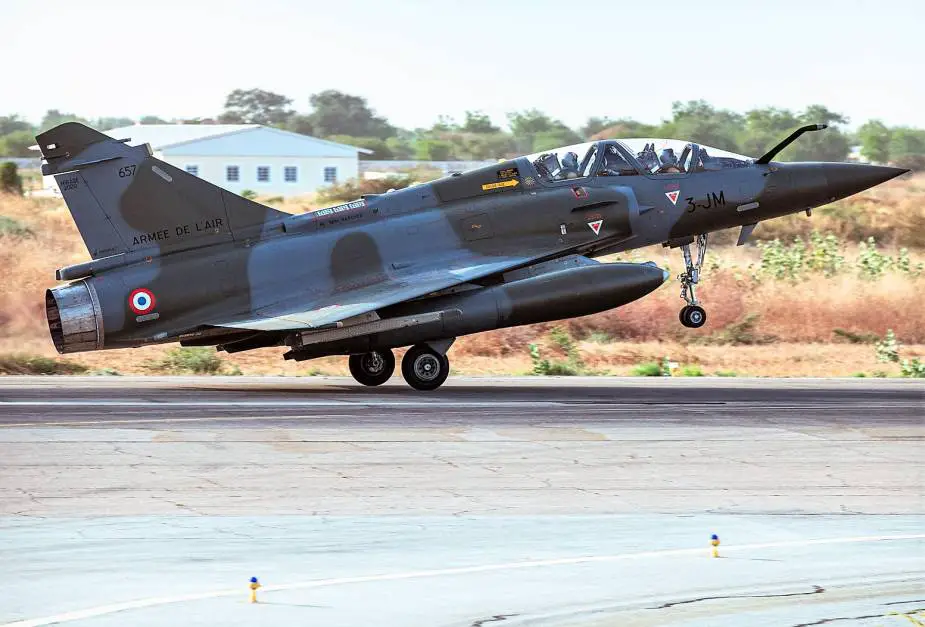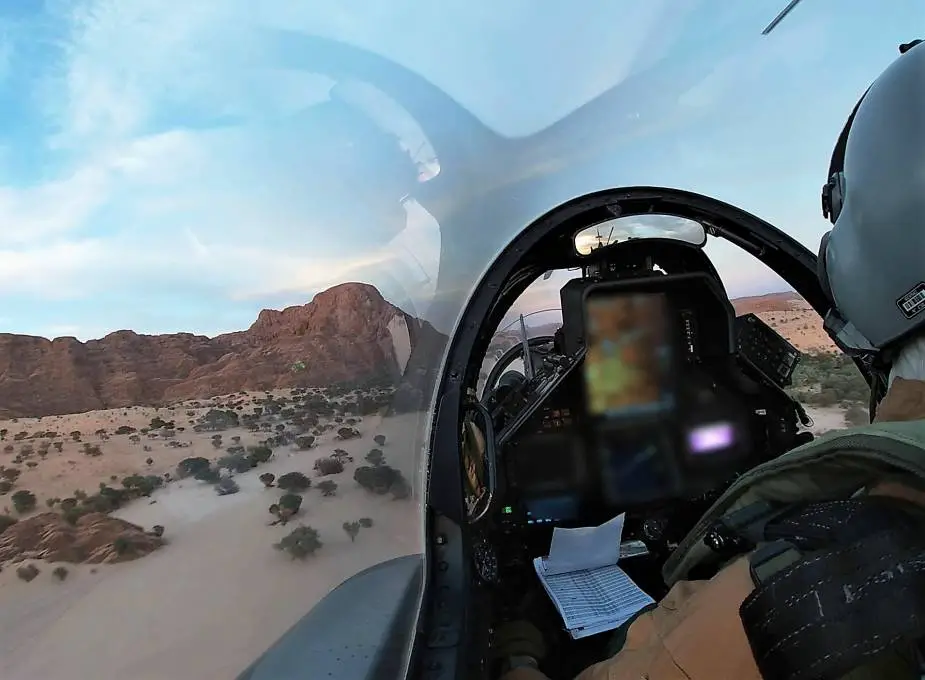Two mid-life updated Mirage 2000D RMVs (rénovés à mi-vie) have been deployed on the N’Djamena BAP (Chad) since the beginning of March. The new capabilities of the fighter-bomber reinforce the air capabilities of the French forces in the Sahel. Zoom on this renovation.
Follow Air Recognition on Google News at this link
 Mirage 2000D RMV (Picture source: Twitter account of French Air and Space Force)
Mirage 2000D RMV (Picture source: Twitter account of French Air and Space Force)
The Mirage 2000D RMV is able to simultaneously carry up to 3 precision-guided weapons, 2 unguided weapons and a laser designation pod. Previously, it only carried two laser-guided bombs in addition to the pod. Eventually, the Mirage 2000D RMV will be able to fire 30mm shells to add additional fire support capability.
Thanks to the new user applications (MONKEY, LION, LIANE or PANDA), the pilot and the navigator communicate instantly from their tablets, in the cockpit, on the interconnected software. Thus the crew flies over the territory of the mission more easily.
The Mirage 2000D is a twin-engine, multi-role combat aircraft developed and manufactured by Dassault Aviation of France. It is an improved variant of the Mirage 2000N, which was designed primarily for nuclear strike missions. The Mirage 2000D, on the other hand, was specifically developed to perform precision strikes with conventional weapons.
The Mirage 2000D entered service with the French Air Force in 1995, and it has since been used in a variety of missions, including close air support, reconnaissance, and interdiction. It was also used in the NATO bombing campaign during the Kosovo War in 1999 and the French intervention in Mali in 2013.
The Mirage 2000D is equipped with a range of advanced avionics and weapon systems, including the Thales RDY radar, a laser rangefinder and designator, and an electronic countermeasures system. It is also capable of carrying a wide variety of weapons, including laser-guided bombs, GPS-guided bombs, and air-to-ground missiles.
One of the most notable features of the Mirage 2000D is its Recoilless Rifle Missile System (RMV), which was developed by MBDA. The RMV is a unique weapon system that allows the Mirage 2000D to engage armored targets at close range. It consists of a 30mm cannon mounted on the aircraft's centerline, which fires high-explosive dual-purpose (HEDP) rounds. The RMV also includes four missile launchers mounted under the aircraft's wings, each of which can carry a single anti-tank missile.
 Two mid-life refurbished Mirage 2000D RMV (rénovés à mi-vie) have been deployed on the N’Djamena BAP (Chad) since the beginning of March. The new capabilities of the fighter-bomber reinforce the air capabilities of the French forces in the Sahel (Picture source: Twitter account of French Air and Space Force)
Two mid-life refurbished Mirage 2000D RMV (rénovés à mi-vie) have been deployed on the N’Djamena BAP (Chad) since the beginning of March. The new capabilities of the fighter-bomber reinforce the air capabilities of the French forces in the Sahel (Picture source: Twitter account of French Air and Space Force)
As Key.Aero recalls, modernization of the Mirage 2000D focused on the avionics system of the aircraft to enable it to use a number of new weapons. For air-to-air missions, the only improvement is the ability to use MICA NG infrared-guided air-to-air missiles as a replacement for the ageing Magic IIs, because the Antipole-5 terrain-following radar of the aircraft has not been replaced by a new type. However, for air-to-ground missions, the aircraft will have its combat capability widely enhanced. The Mirage 2000D RMV is able to carry and use GBU-48, GBU-49, GBU-50 and Sagem’s AASM, equipped with all-weather GPS navigation combined with precision terminal laser guidance. The RMVs will also be capable of using Thales/TDA Air-Sol Petite Taille Tactique (ASPTT) small-diameter tactical air-to-ground bombs. The upgraded Mirage 2000Ds are also capable of using the CC422 30mm Cannon pod, a shortened version of CC420 fitted to the Mirage F1B.
To use new weapons and also to have enhanced mission capabilities, the Mirage 2000D RMVs are modified to operate the Targeting Long-range Identification Optronic System (TALIOS) targeting pod instead of the ageing ATLIS II, PDL CTS and Damocles currently in use by them. TALIOS is a multipurpose two-in-one pod developed by Thales to meet the AAE requirements for its Rafale F3-R standard fighter jets. The TALIOS pod doesn't just provide targeting capability, but rather is an asset for tactical reconnaissance as it delivers high-resolution and color imagery. The permanent vision and embedded artificial intelligence of the pod not only enable pilots and weapon system operators to perform their air-to-ground missions more effectively than before but also provides reliable situational awareness for the ground forces in real time.
Also, in addition to receiving new VHF-FM radios, a new Link-16 database system will be installed that’s capable of transmitting video and images from the TALIOS pod to the units on the ground.
The 3rd Fighter Wing of the AAE at BA133 Nancy-Ochey currently has 35 targeting pods in use. There are nine ATLIS II daytime laser designators, 20 PDL CTS day-and-night targeting pods and six Damocles MP all-weather targeting pods. In addition to them, the wing has four ASTAC Electronic Intelligence (ELINT) pods which are being used for monitoring activities of the Russian military presence in the Crimean peninsula and the Black Sea.
At least two of the targeting pods of the 3rd Fighter Wing are on loan by the Fighter Experiment Squadron (ECE) 1/30 ‘Côte d’Argent’ at BA118 Mont-de-Marsan, while four to six are always on assignment to French overseas airbases to be used by Mirage 2000Ds involved in Operation Barkhane and Chammal. In the Middle East, they can be found in H4 Air Base in Jordan and Al-Dhafra Air Base in UAE, while in Africa they are in Niamey in Niger.
ATLIS-II is a day-only system capable of designation for GBU-12 laser-guided bombs. This was the first targeting pod ever used by the Mirage 2000Ds. The pod was supplemented by a Pod de Désignation Laser-Caméra Thermique (PDL-CT) that provides thermal imaging designation thanks to its improved Synergie infrared sensor that gives a 40% increase in image resolution. These pods are obsolete today as they have limited capabilities and the low-resolution quality of the video feed. The AAE initially replaced them with the more modern Thales Damocles MP and is now upgrading them with the state-of-the-art Thales TALIOS.
















